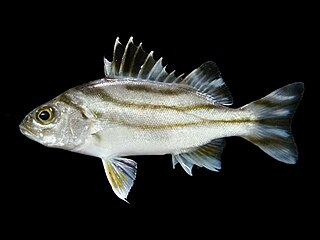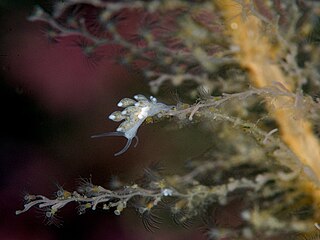
Peter Forsskål, sometimes spelled Pehr Forsskål, Peter Forskaol, Petrus Forskål or Pehr Forsskåhl was a Swedish-speaking Finnish explorer, orientalist, naturalist, and an apostle of Carl Linnaeus.

A salp or salpa is a barrel-shaped, planktonic tunicate in the family Salpidae. It moves by contracting, thereby pumping water through its gelatinous body, one of the most efficient examples of jet propulsion in the animal kingdom. The salp strains the pumped water through its internal feeding filters, feeding on phytoplankton.

Rabbitfishes or spinefoots are perciform fishes in the family Siganidae. The 29 species are in a single genus, Siganus. In some now obsolete classifications, the species having prominent face stripes—colloquially called foxfaces–are in the genus Lo. Other species, such as the masked spinefoot, show a reduced form of the stripe pattern. Rabbitfishes are native to shallow waters in the Indo-Pacific, but S. luridus and S. rivulatus have become established in the eastern Mediterranean via Lessepsian migration. They are commercially important food fish, and can be used in the preparation of dishes such as bagoong.
Pterotrachea is a taxonomic genus of medium-sized to large floating sea slugs, marine pelagic gastropod molluscs in the family Pterotracheidae, which is in the infraorder Littorinimorpha. As such they are quite closely related to such families as the tritons (Ranellidae) and the tun shells (Tonnidae).

Terapon jarbua, the jarbua terapon, crescent grunter, crescent banded grunter, crescent perch, spiky trumpeter, thornfish or tiger perch, is a species of ray-finned fish, a grunter of the family Terapontidae. It occurs in the Indo-Pacific. it is an important commercial species within its range and is sometimes found in the aquarium trade where it is known as "target fish" for the pattern visible from above.

The reticulate whipray or honeycomb stingray is a species of stingray in the family Dasyatidae. It inhabits coastal waters in the western Indian Ocean including the Red Sea, Natal and the Arabian Sea; also a Lessepsian transmigrant in the eastern Mediterranean. A large species reaching 2 m (6.6 ft) in width, the reticulate whipray has a diamond-shaped pectoral fin disc and an extremely long tail without fin folds. Both its common and scientific names refer to its ornate dorsal color pattern of many small, close-set dark spots or reticulations on a lighter background. However, the reticulate whipray is only one of several large spotted stingrays in the Indo-Pacific which, coupled with the variability of its coloration with age and locality, has resulted in a great deal of taxonomic confusion.

Doto coronata is a species of small sea slug or nudibranch, a shell-less marine gastropod mollusc in the family Dotidae. It is the type species of the genus Doto.

Felimida grahami is a species of colourful sea slug, a dorid nudibranch, a marine gastropod mollusc in the family Chromodorididae.

Eubranchus exiguus is a species of small sea slug, an aeolid nudibranch, a marine gastropod mollusc in the family Eubranchidae.

Cavolinia tridentata is a species of sea butterflies, floating and swimming sea snails or sea slugs, pelagic marine gastropod molluscs in the family Cavoliniidae. It is a common species and is wide spread, being found in European waters, the Atlantic Ocean, the Caribbean Sea, the Gulf of Mexico, the Indian Ocean and in the Pacific Ocean. It lives in the photic zone of the ocean between 0 to 30m in depth.

Tergipes is a genus of sea slugs, specifically aeolid nudibranchs, marine gastropod molluscs in the family Tergipedidae. Tergipes is the type genus of the family Tergipedidae.
Flabellina dushia is a species of sea slug, an aeolid nudibranch, a marine gastropod mollusc in the family Flabellinidae.

Flabellina engeli is a species of sea slug, an aeolid nudibranch, a marine gastropod mollusc in the family Flabellinidae.

Coenobita scaevola is a species of terrestrial hermit crab from the western Indian Ocean and Red Sea.

Onchidoris proxima is a species of sea slug, a dorid nudibranch, a shell-less marine gastropod mollusc in the family Onchidorididae. This species is found in the northeastern and northwestern parts of the Atlantic Ocean. It is also reported from the northeastern Pacific Ocean. Previously in the genus Adalaria this species was moved to Onchidoris as a result of a molecular phylogeny study.

Tenellia phoenix is a species of sea slug, an aeolid nudibranch, a marine gastropod mollusc in the family Fionidae.
Berghia dakariensis is a species of sea slug, an aeolid nudibranch. It is a shell-less marine gastropod mollusc in the family Aeolidiidae.

Dendrodoris krebsii is a species of sea slug, a dorid nudibranch, a marine gastropod mollusc in the family Dendrodorididae.

Siganus rivulatus, the marbled spinefoot, rivulated rabbitfish or surf parrotfish, is a gregarious, largely herbivorous ray-finned fish of the family Siganidae. Its natural range encompasses the western Indian Ocean and the Red Sea from where it colonised the Mediterranean Sea by Lessepsian migration through the Suez Canal. It is the type species of the genus Siganus.

Portunus segnis, the African blue swimming crab, is a species of crustacean, a swimming crab belonging to the family Portunidae. While native to the western Indian Ocean, it is also invasive in the Mediterranean. It is thought to have come through the Suez Canal from the Red Sea but it may have been transported by ships.

















